Here it is: Total Football Analysis‘ inaugural NWSL post-match tactical analysis. With a team named Thorns taking on Pride, this is a game steeped in religious imagery. With this in mind, and it being the inaugural TFA women’s domestic football article, this could be an interesting framework through which to assess this game. As we enter the Genesis of TFA’s women’s football journey, let us try to understand how the attacking crown of Thorns exposed the sins of Pride.
In this tactical analysis, we shall see how both coaches opted for relative consistency in their starting shapes but this only allowed well-understood concerns to come to the surface, again. Portland’s quick combinations and switching looked to target Orlando Pride’s aerial weaknesses at the back. Whilst withdrawing their talisman, Marta, did help prevent the Thorns from tearing them to shreds, it also bolstered their attack. The Brazilian herself was crucial in two of her team’s goals, scoring one and forcing an own goal for the second.
Ultimately, in a game-ending with seven goals, we can’t overestimate defensive weaknesses. As we shall see, by the second half, Portland’s midfield blockade was undone by Marc Skinner’s tactical ingenuity. Fortunately, however, the home side could capitalise on their opponents’ own weaknesses to snatch a fourth goal with the last play of the game.
Tactical analysis: line-ups and tactics
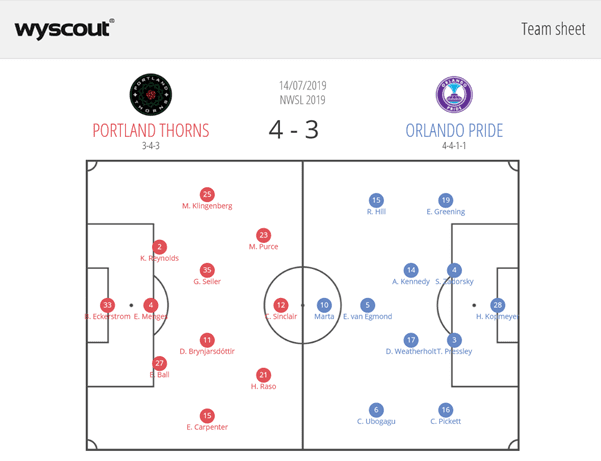
Starting with the home side, Thorns’ head coach Mark Parsons went for, on paper, an as yet unseen-in-2019 3-4-3 formation. Parsons has used similar variations to the three-player backline in his last two games, favouring 3-4-2-1 set-ups against Seattle Reign and Houston Dash.
The only change which Parsons opted for from his side’s last game was the replacement of Caitlin Foord with Hayley Raso. Both returned stateside following Australia’s dismal showing at the Women’s World Cup in France. With Tobin Heath due to return following the USA’s victory, it was imperative that this duo gave an impressive performance to retain a place in the first team.
In the geographically diametrically-opposite city of Orlando, the air of recent tactical consistency must also be strong. Just as Parsons retained a recent tactical trend, his British compatriot Skinner has also stuck to a recently trusted formation. The 4-4-1-1, which exorcised Washington Spirit a week prior, was reused.
His playing personnel has also been largely consistent recently, with the back end of the World Cup solidifying his first XI choices. The major re-addition to the starting team was the iconic Marta, who had a tangible impact on proceedings at Providence Park.
Another cross-making Carpenter
Innovation is the name of the game and whilst it’s been seen before, there was a certain reliability about the Thorns’ passing which deserves commenting on. When advancing forward, and particularly in the first half when Ellie Carpenter found herself in acres of space on the right, we noticed an attacking “envelope” take shape.
Shockingly, Carpenter is a nominal right-back or right wing-back. Just for a comparison, we can see her season heat map compared to her heat map from this particular game, below:

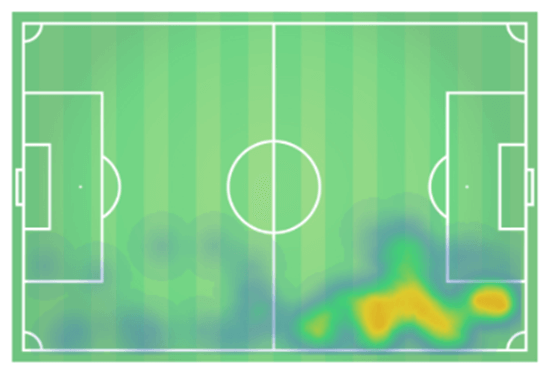
What is abundantly clear is how advanced she was playing. She was the crucial and supposedly final element for the attacking “envelope”. She was the glue which seals it shut, the penultimate part of the process before despatch. According to Wyscout, Carpenter’s right-flank was where 15 of their 37 attacks emerged. With only 0.06xG coming from these attacks, however, it was not without its limitations.
In the below graphic, we can see how Portland Thorns’ attack advanced with this enveloping-style. Portland’s desire to move the ball from the back and split the Pride’s forward line by playing the ball to a wide full-back, before teasing it back centrally before they could rejig their shape, served to help this.
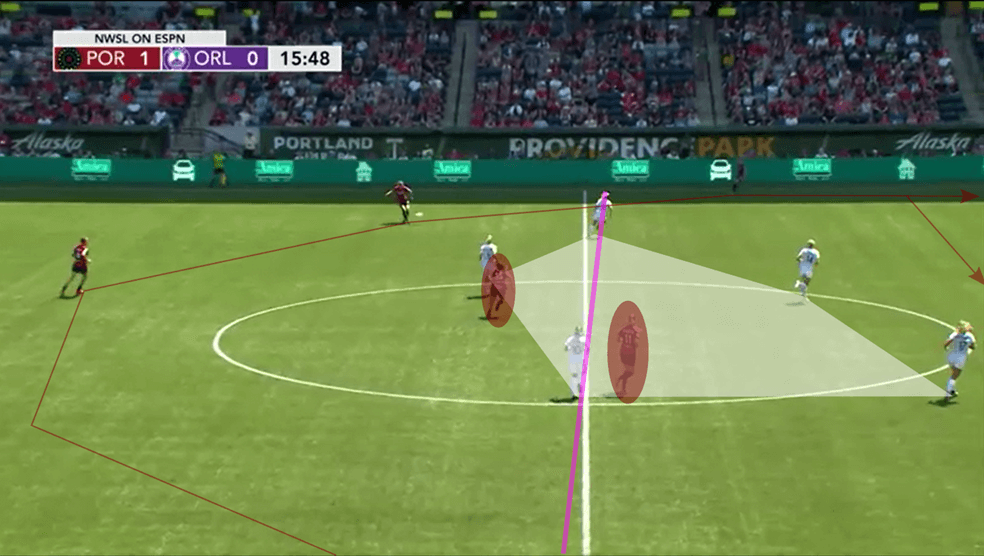
By quickly switching play and keeping width, Orlando were unable to offer any measured resistance – it was much easier to try and retain solidity in the middle. This played into Portland’s plan. Furthermore, by dropping their centre midfielders deeper, this preoccupied Orlando’s forward line, taking three potential defenders out of the game through sheer rapidity. Once the ball was on the left it could proceed down that flank or more likely, look to come back to the right and utilise Carpenter.
Despite her role in the game, by the second half, Carpenter was a fleeting presence. Ultimately, Portland’s central area proved to be much more effective for generating higher xG chances (0.26xG – an 81% chance of scoring). All the same, perhaps Portland didn’t help their attack by losing some midfield authority in the second half.
The sin of Pride
In the first half, Carpenter and co. had their run of the Pride defense through clever combination play, an energised high-press, and some outstanding, yet disciplined movement. Whilst in the second half Orlando managed to contain this somewhat, there was a particular threat which never really disappeared: the Pride’s almost inevitable defensive self-destruction.
Particularly in the air, neither of the Pride’s defensive pairing of Shelina Zadorsky and Toni Pressley looked comfortable. Midge Purce had an excellent game and the breadth of her attacking portfolio made her opponents run in circles and confused them like a hypnotised Pokémon. In the second half though, she didn’t really need to do too much.
The below graphics demonstrate Zadorsky and Pressley’s collective aerial battles. Whilst the two did have to face the Thorns’ rampant attack, the fact that they proved so weak when defending the ball in the air within their own penalty area, is very concerning.
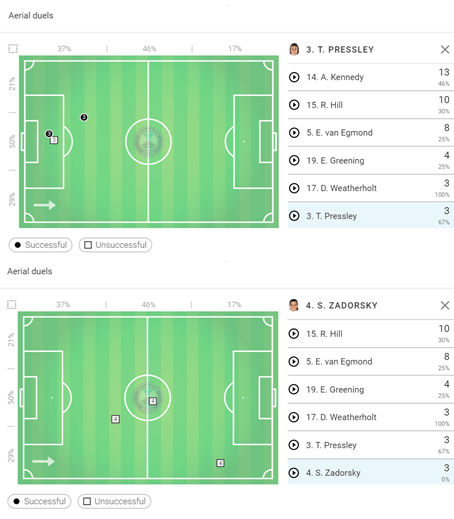
Portland made 23 crosses in the game, their second-highest of their campaign so far. Only six were successful, however. At the same time, the two only won two headers between them, with just one inside the penalty area. Indeed, the last three of Portland’s goals came from poor defensive heading in practice.
The explanation for their poor aerial record and their defensive dysfunction perhaps has longer-term, more chronic cause, however. An observation which became apparent from as early in the game as it took Portland to score, (roughly two minutes in), was that they were lacking in the transition.
Orlando Pride are a regimented team, with all the rigidity and fragility of a china table with one leg shorter than the other three. When they attacked, they played with a high defensive line, which led to easy lobs over the top. When they defended, they were perilously unable to push high and clear their lines. The former is shown below, even though they were fortunate that Portland were even slower to react and were rightly called offside.
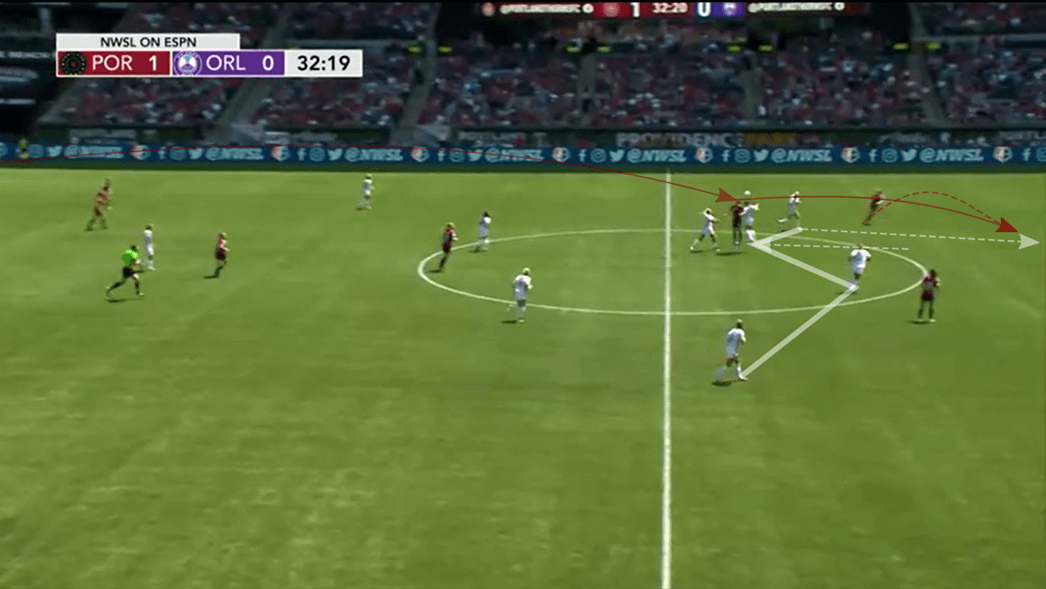
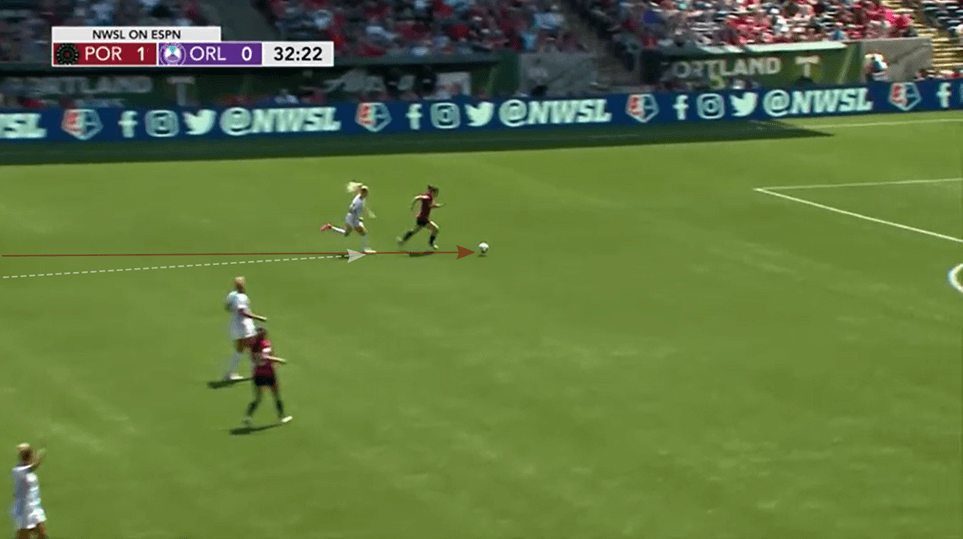
Often, the Pride were simply in the wrong starting positions to challenge for headers. The high line could work but with Portland’s ability to move between the lines and then play on the shoulder, Orlando were naive in their defensive positioning.
Marta parts the Red (and Black) Sea
Perhaps the most significant innovation which Skinner introduced in the second half was the centralisation of Marta, which later coincided with her taking a much more withdrawn role. Whilst in the first half the Brazilian was increasingly drawn into a left-wing position and consequently berated by ESPN’s peppy commentary team for neglecting her defensive duties, Skinner saw that this was an unnatural fit.
As the graphics below demonstrate, by the second half, Marta (#10) was operating as much more of an attacking midfielder. In more precise terms, she was the “hook”, the enganche, who seamlessly brought together the two disparate parts of the Pride’s team. Whilst the first half saw a dilapidated defence struggle to move the ball into advanced areas, with Marta offering this decisive link, they had much more success in the second half.
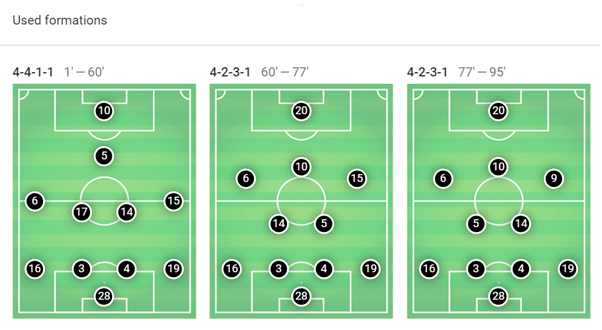
The way Marta transformed the attack sounds rudimentary but it is certainly worth exploring. A common theme seemed to be her dropping centrally and allowing for runners to move past her. An enduring image of how this loss occurred could be seen from Marta’s frustration at being blockaded by a Portland defensive wall, with no runners moving off of her.
The second half saw her withdrawn positioning give their weak attacking transition a leg-up, as it opened up clearer spaces for her colleagues to advance into. Even more so, however, she used this withdrawn position to make defence-splitting runs. Orlando Pride’s second goal, an Emily Menges own goal, was a perfect example of this.
As we can see below, as Chioma Ubogagu advanced with the ball, Marta herself had been in retreat to help pressure and win the ball which was crucial at launching the attack. Notably, whilst in the first half Orlando had a passes allowed per defensive action (PPDA) of 23.3 but cut this to 7.8 by the time of the goal. Marta’s defensive contribution was tangible.
After Ubogagu spotted Marta moving between the lines from deep, Portland’s static midfield pairing could not track and follow her. She had space and composure to pull a ball across, which Menges deflected over Britt Eckerstrom in goal. In the first half, Marta was isolated but through her own endeavours, she singlehandedly transformed her side’s attack.
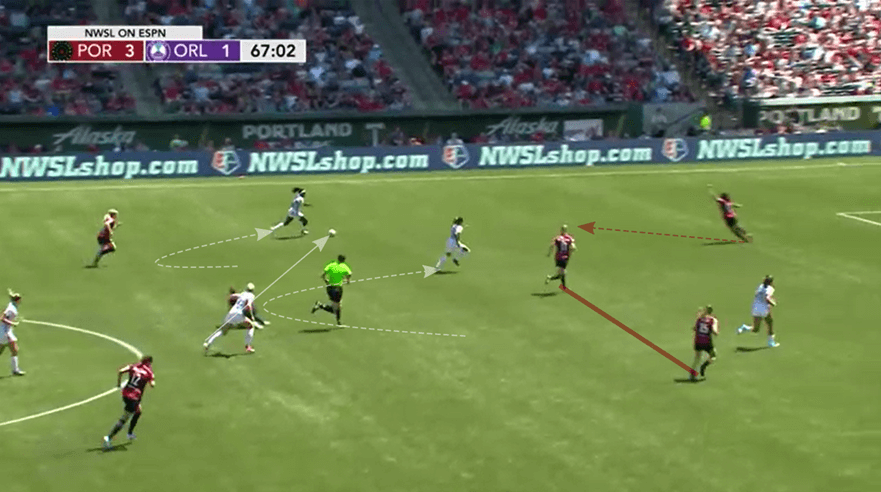
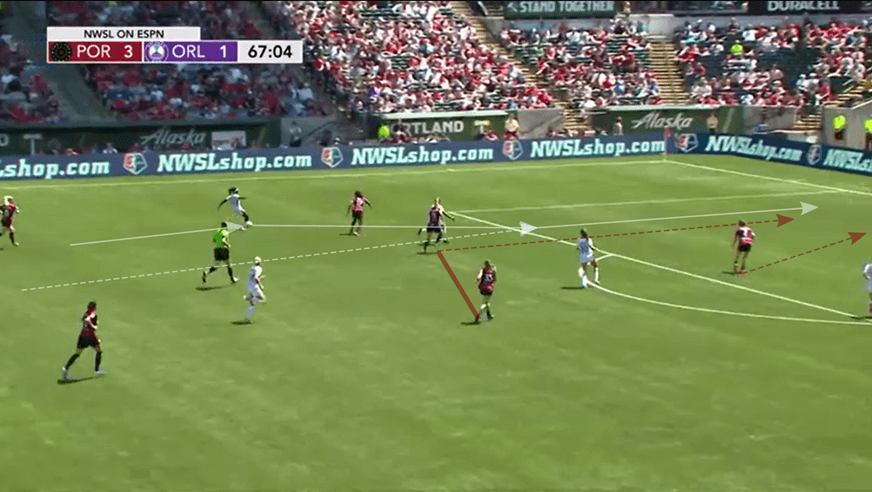
Portland’s midfield Exodus
Whilst their “attacking envelope” was so lauded in the first half, by the second half and through Skinner’s tactical rearrangements, its weaknesses had become clearer. In retrospect, however, by the end of the first half, this was increasingly apparent.
The first thing of note with Portland Thorns’ approach was that by pushing their central pairing higher or lower but never in the middle, they were enabling gaping passing lanes and spaces between the lines. In the below, we can see how this was Orlando were looking to exploit this as early as half an hour into the game:
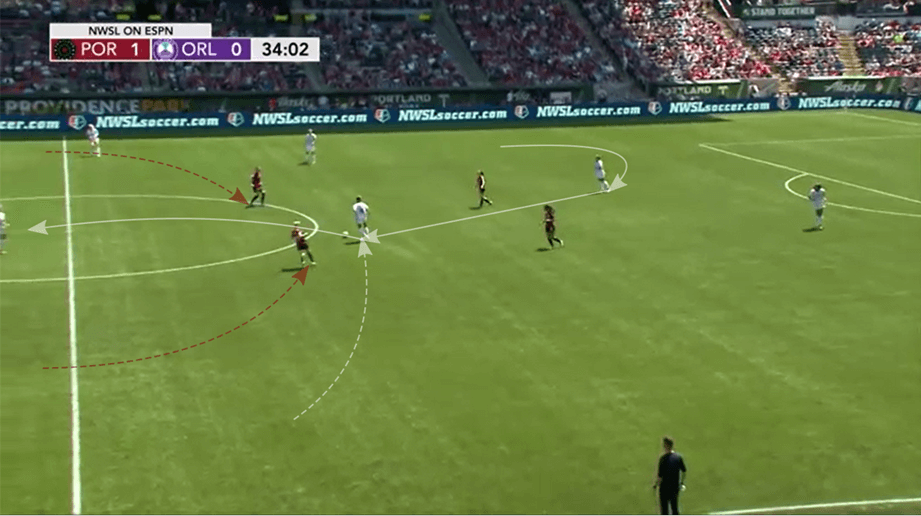
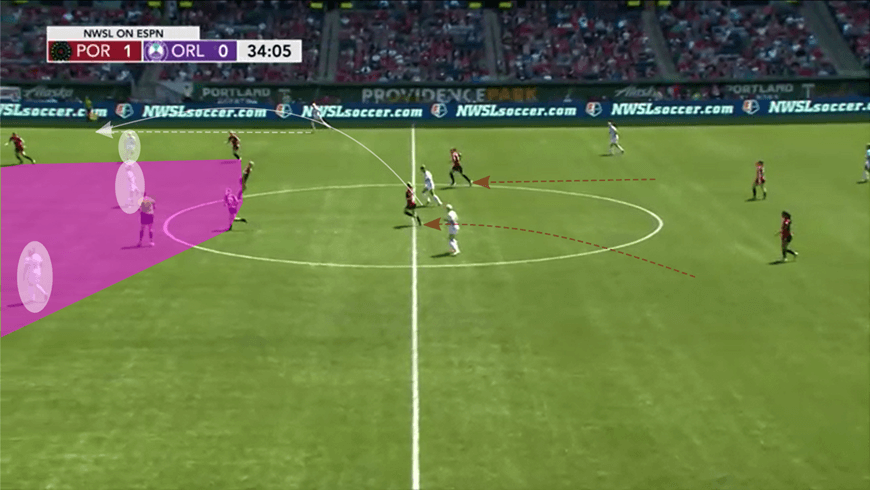
With their left-back moving inside to win the ball between the centre forwards, the extreme depth of Dagný Brynjarsdóttir and Gabby Seiler meant that a huge gap existed for Orlando to advance into. As the wing-backs moved inside to close the space, still Brynjarsdóttir and Seiler have dropped off.
At the same time, the Portland defensive line is even deeper. Three Pride players are in their own space and furthermore, with their wing-backs being forced inside to close the ball down, huge channels now opened on each flank. Unsurprisingly, the Pride looked to move the ball in this area.
By the time the second half had rolled around, however, this defensive shape was further undone as Marta moved deeper with regularity. By offering greater possibilities in the middle of the park, this previously solid midfield line had to become more flexible to deal with the threat. As one would push further forward, the other would retreat. Portland hoped to cover all their bases but as Marta’s rocket from 25 yards showed, they were dangerously exposed.
The below graphic demonstrates the respective positions each side took when Marta unleashed her thunderbolt drive just after the hour mark. Both Brynjarsdóttir and Seiler had poor starting positions (marked in red). With their staggered shape, an angled pass through the two enabled Marta to push further forward to receive the ball unmarked and score.
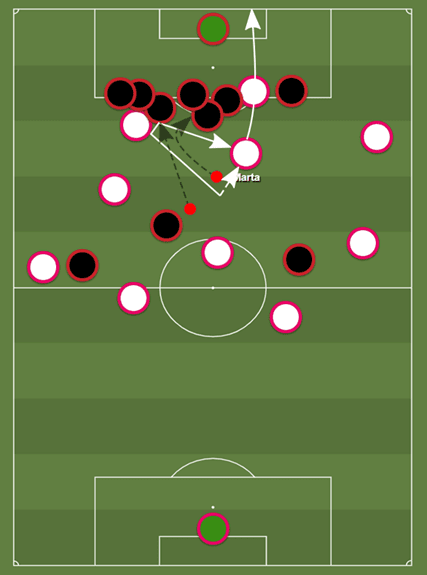
The decline in Portland’s defensive midfield prowess is evident in the statistics. Seiler, for instance, averaged a defensive duel success percentage of 79% across the whole game. Over the second half, however, this was just 57%.
For Brynjarsdóttir, in all fairness, her defensive contribution was bumped by an excellent 82% second-half defensive success rate, providing a respectable 78% across the game. Although as the below graphic shows, she only won defensive duels within her team’s own defensive third. Therefore, we can argue that she was weak when required to defend higher, likely because she lacked support.
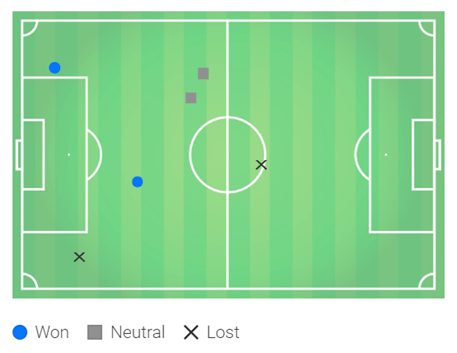
All of this suggests that the centre midfielders had notable weaknesses when playing together more laterally. They were often dropping too deep and this encouraged space between the stratified lines and out wide. Yet, when they were split in the second half with one pushing further forward, they were also unable to deal with Orlando’s packed attack. Perhaps it would have suited Portland to sure up their midfield by adapting to more of a 3-5-2.
Conclusions
In all honesty, the large scoreline seemed to really showcase a catalogue of tactical insecurities for each of these teams. Whilst Portland were perhaps the better team over the entirety of the game, they were incredibly fortunate that they could still rely on Orlando’s defensive failings at the end of the game. Tactically-speaking, Skinner was bolder and more proactive as the game progressed. Parsons was much more dogmatic and maybe some more wholescale changes would have saved the fingernails of the Portland faithful.
With 12 games have already gone this season, the Thorns will need to make sure that they can prevent future collapses if they are to keep pace with North Carolina Courage, who they are level with on points at the top of the table. On the other end of the spectrum, Orlando Pride have played the most games of all the NWSL’s competitors (13) but find themselves on only eight points – level with bottom-placed Sky Blue. Going into the fixture, this was a David vs Goliath-like battle and whilst David took it to the wire, the giant took the expected spoils of victory.

If you love tactical analysis, then you’ll love the digital magazines from totalfootballanalysis.com – a guaranteed 100+ pages of pure tactical analysis covering topics from the Premier League, Serie A, La Liga, Bundesliga and many, many more. Buy your copy of the July issue for just ₤4.99 here, or even better sign up for a ₤50 annual membership (12 monthly issues plus the annual review) right here.

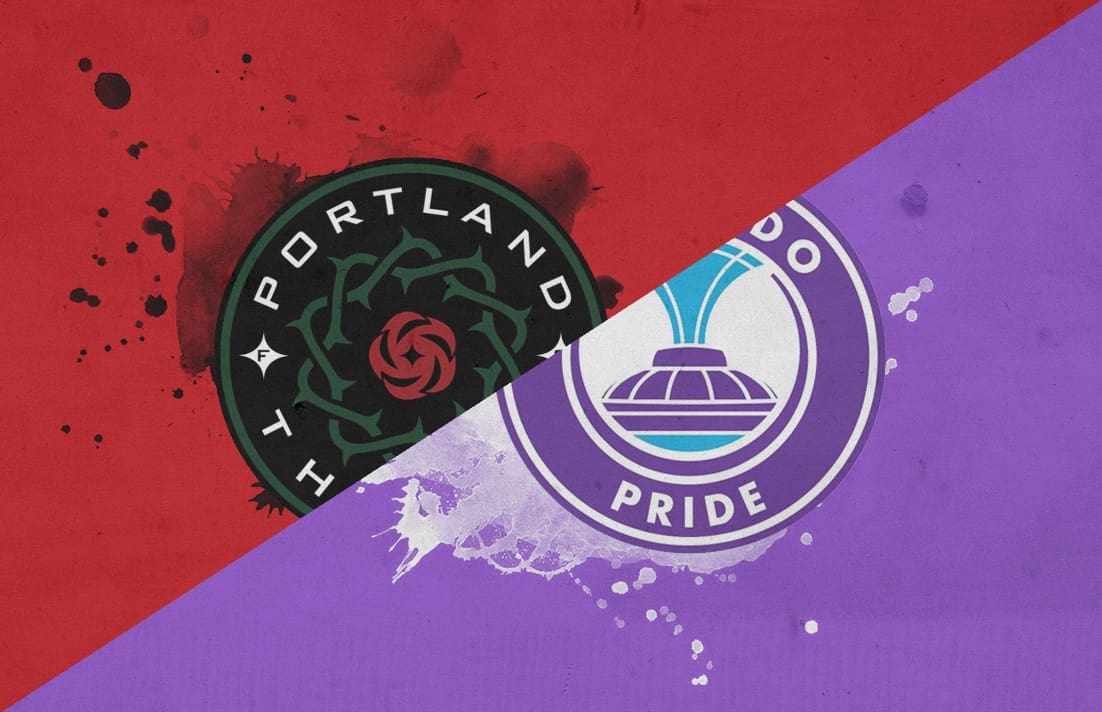



Comments